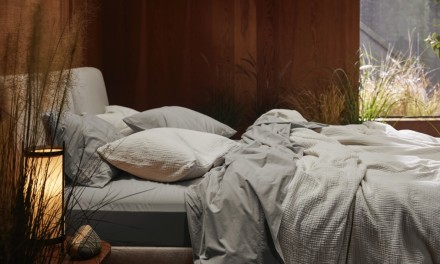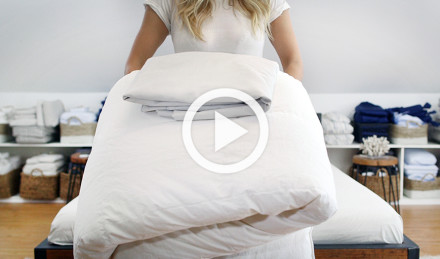Nearly two-thirds of Americans now view climate change as a major threat, and 85% have made an effort to make greener purchases over the last five years. If you're among the growing number of eco-conscious shoppers, you might be wondering how to make your lifestyle more earth-friendly.
Choosing eco-friendly fabrics is a great place to start. Keep reading to learn about the importance of sustainable consumerism, what fabrics are sustainable and how to tell if a material is good for you and the planet.
What Is Sustainable Fabric?
Sustainable fabric is a textile sourced from renewable, recycled or otherwise ecologically friendly materials and made with ethical manufacturing and logistical processes. The term sustainability essentially means the needs of businesses and consumers are met without affecting the ability of the next generation to meet its own needs.
The Importance of Choosing Sustainable Textiles
While businesses and governments bear a lot of responsibility for the current and future state of the planet, sustainability is still mainly a grassroots effort. Still, small changes add up, and there's a lot you can do in your everyday life to support the environment.
In addition to recycling, composting, cutting down on your energy use, using biodegradable cleaning products and wearing sustainable fashion materials, you can choose eco-friendly fabrics for your home.
Ethically made fabric isn't simply woven from earth-friendly materials. The raw plant fibers are farmed and harvested by humanely treated laborers and loomed by artisans and factory workers who are paid a fair wage. In other words, the entire supply chain has the well-being of not only the planet but also its people and the economy in mind.
Want more tips for green living? Here are 35 Eco-Friendly Home Products and Necessities for a Sustainable Household.
What Is Sustainable Fabric?
Sustainable fabric is a textile sourced from renewable, recycled or otherwise ecologically friendly materials and made with ethical manufacturing and logistical processes. The term sustainability essentially means the needs of businesses and consumers are met without affecting the ability of the next generation to meet its own needs.
The Importance of Choosing Sustainable Textiles
While businesses and governments bear a lot of responsibility for the current and future state of the planet, sustainability is still mainly a grassroots effort. Still, small changes add up, and there's a lot you can do in your everyday life to support the environment.
In addition to recycling, composting, cutting down on your energy use, using biodegradable cleaning products and wearing sustainable fashion materials, you can choose eco-friendly fabrics for your home.
Ethically made fabric isn't simply woven from earth-friendly materials. The raw plant fibers are farmed and harvested by humanely treated laborers and loomed by artisans and factory workers who are paid a fair wage. In other words, the entire supply chain has the well-being of not only the planet but also its people and the economy in mind.
Want more tips for green living? Here are 35 Eco-Friendly Home Products and Necessities for a Sustainable Household.
Sustainable Fabric Certifications
It's easy for companies to make big claims about their sustainability efforts and ethical supply chains. However, it can be hard to tell what's sincere versus what's merely marketing. So, how do you know if an eco-friendly fabric is, in fact, eco-friendly?
There are a handful of third-party organizations that independently evaluate sustainability claims. If a brand or product meets the criteria, it can become certified and carry a seal showing it's up to par. Labels to look out for include Oeko-Tex Standard 100, GOTSⓇ, and RDS. Here's what to know.
Oeko-Tex Standard 100
The Oeko-Tex Standard 100 label certifies that a textile was tested for upwards of 100 potentially harmful substances. From raw fibers and threads to dyes and buttons, every component of a product is evaluated.
Various textiles can carry the seal, including bedding, towels, clothing and curtains — to name just a few. When you see the label, you know you're buying a non-toxic material that's safe for both you and the environment.
For a deeper dive into the Standard 100 certification, see our blogs:
What Is Oeko-Tex Standard 100 Certification?
Best Oeko-Tex Sheets, Towels, Curtains, & More
Global Organic Textile Standard (GOTSⓇ)
The Global Organic Textile Standard (GOTS) is the world's leading certifier of organic fabrics. Beyond confirming a product was made from organically grown, sustainable fibers, the organization ensures every stage of the supply chain meets its ecological and social criteria. This includes initial processing, spinning, weaving, knitting, wet-processing, manufacturing and trading.
For more insight, check out our article, What Is GOTS, and Why Should You Care About This Textile Certification?
Responsible Down Standard (RDS)
The Responsible Down Standard (RDS) isn't about eco-friendly fabric but rather what goes inside it. It certifies that natural down or feather-filled products, such as duvets and pillows, are sourced from humanely treated ducks and geese in compliance with animal welfare criteria.
Learn more about this comfy bedding fill material in our blog, Down Comforter 101: What is Fill Power?
Sustainable Fabric Certifications
It's easy for companies to make big claims about their sustainability efforts and ethical supply chains. However, it can be hard to tell what's sincere versus what's merely marketing. So, how do you know if an eco-friendly fabric is, in fact, eco-friendly?
There are a handful of third-party organizations that independently evaluate sustainability claims. If a brand or product meets the criteria, it can become certified and carry a seal showing it's up to par. Labels to look out for include Oeko-Tex Standard 100, GOTSⓇ, and RDS. Here's what to know.
Oeko-Tex Standard 100
The Oeko-Tex Standard 100 label certifies that a textile was tested for upwards of 100 potentially harmful substances. From raw fibers and threads to dyes and buttons, every component of a product is evaluated.
Various textiles can carry the seal, including bedding, towels, clothing and curtains — to name just a few. When you see the label, you know you're buying a non-toxic material that's safe for both you and the environment.
For a deeper dive into the Standard 100 certification, see our blogs:
What Is Oeko-Tex Standard 100 Certification?
Best Oeko-Tex Sheets, Towels, Curtains, & More
Global Organic Textile Standard (GOTSⓇ)
The Global Organic Textile Standard (GOTS) is the world's leading certifier of organic fabrics. Beyond confirming a product was made from organically grown, sustainable fibers, the organization ensures every stage of the supply chain meets its ecological and social criteria. This includes initial processing, spinning, weaving, knitting, wet-processing, manufacturing and trading.
For more insight, check out our article, What Is GOTS, and Why Should You Care About This Textile Certification?
Responsible Down Standard (RDS)
The Responsible Down Standard (RDS) isn't about eco-friendly fabric but rather what goes inside it. It certifies that natural down or feather-filled products, such as duvets and pillows, are sourced from humanely treated ducks and geese in compliance with animal welfare criteria.
Learn more about this comfy bedding fill material in our blog, Down Comforter 101: What is Fill Power?
Best Eco-Friendly Fabrics
The most sustainable fabrics go beyond an ethical, eco-conscious supply chain. What happens to the material when a product is discarded is also a concern, as 85% of the world's textiles end up in landfills. Fashion production, in particular, accounts for 10% of all carbon emissions.
With this in mind, the best fabrics are made of recycled or biodegradable materials. When buying household linens and clothing, consider organic cotton, linen, percale, sateen, brushed cotton, wool, silk, down or down alternative.
Want to minimize your footprint? Here's How to Donate, Recycle and Reuse Old Bed Sheets and Towels.
What Is Organic Cotton?
Best Eco-Friendly Fabrics
The most sustainable fabrics go beyond an ethical, eco-conscious supply chain. What happens to the material when a product is discarded is also a concern, as 85% of the world's textiles end up in landfills. Fashion production, in particular, accounts for 10% of all carbon emissions.
With this in mind, the best fabrics are made of recycled or biodegradable materials. When buying household linens and clothing, consider organic cotton, linen, percale, sateen, brushed cotton, wool, silk, down or down alternative.
Want to minimize your footprint? Here's How to Donate, Recycle and Reuse Old Bed Sheets and Towels.
What Is Organic Cotton?
Organic cotton is sourced from organically grown cotton plants. They're planted from non-genetically modified seeds and farmed without the use of artificial fertilizer, synthetic pesticides and other potentially toxic chemicals. The eco-friendly fabric is also produced with less water and energy than traditional cotton.
Get more insight in our article, What Is Organic Cotton? Everything to Know About This Sustainable Cotton Fabric
Organic Cotton Essentials to Consider
With an increasing demand for organic fabrics, a wide range of GOTS-certified products are available today. This includes organic cotton towels, bath mats, bedding sets, throws, pants, shirts and bathrobes.
Interested in getting the best organic cotton products for your home? Check out these helpful guides:
Best Organic Robes: What to Look for in an Organic Bathrobe
Best Organic Sheets: What to Look for in Organic Cotton Bedding
Best Organic Clothing: What to Look for In Organic Clothes & Loungewear
What Is Linen?
Linen is a sustainable fabric. It's sourced from flax plants typically grown in Europe with minimal pesticides, often requiring no more water than the region's annual rainfall. The raw fibers are exceptionally lightweight yet durable, which makes for a breathable, long-lasting material that gets softer with time.
Why Is European Flax Linen the Best in the World? Read our blog to find out.
Linen Essentials to Consider
Linen is among the most popular bedding materials on account of its unmatched durability, increasing softness, unique airiness and laid-back elegance. The easy-breezy textile is also a favorite for casual clothing, loungewear, robes, window coverings, shower curtains, napkins and tablecloths.
Check out these Table Linen Styling Tips before hosting your next gathering.
What Is Percale?
Percale is a high-quality fabric made out of long-staple Egyptian cotton. The long plant fibers provide strength and softness while ensuring breathability throughout the night. Featuring a plain square weave with a cool, crisp matte finish, this sustainable material is long-lasting and biodegradable.
For more details, see our article, Percale: Know Your Bedding Like a Designer.
Percale Essentials to Consider
You can get all types of percale bedding. We're talking ultra-cozy and lightweight sheet sets, fitted sheets, pillowcases, duvet covers, shams, crib sheets and even decorative shams for square Euro pillows.
Not sure what color to get for your bed linens? Take a look at these Bed Sheet Color Trends for inspiration.
What Is Sateen?
Sateen is woven from long-staple Egyptian cotton. It's similar in quality to percale, except that it's loomed with a four-over-one-under thread pattern instead of the one-over-one-under plain square technique. This gives the eco-friendly fabric an exceptionally smooth, slightly silky feel and a subtle sheen.
Dive deeper with our blogs:
Sateen: Know Your Bedding Like a Designer
Sateen vs. Satin vs. Silk: What’s the Difference?
Sateen Essentials to Consider
If you like the silkiness of satin but prefer natural fabrics, sateen bedding is an excellent choice. Options include sheets, pillowcases, comforter covers, shams and complete bedding bundles for those who want to go all out.
What Is Brushed Cotton?
Brushed cotton is a casually cool fabric with a premium appeal. Featuring a plain square weave, the garment-washed material is finished with a brushing technique to fluff up the fibers on one side. This creates a buttery-soft feel and just the right amount of insulation to keep you cozy without overheating.
Learn more in our article, Brushed Cotton: Know Your Bedding Like a Designer.
Brushed Cotton Essentials to Consider
Brushed cotton is a go-to for bedding among those who get cold at night. The eco-friendly fabric comes in everything from sheets and duvet covers to pillowcases and shams.
Curious about how cotton compares to linen? Explore the Linen vs. Cotton Sheeting guide.
What Is Wool?
Wool is a natural fiber sourced from the hides of sheep. The eco-friendly material is long-lasting, biodegradable and considered renewable since the animals' coats regrow notably fast. Offering the best of all worlds, it's inherently warm with insulating properties but also moisture-wicking and breathable.
What Is Merino Wool? Learn more in our blog.
Wool Essentials to Consider
Wool is one of the most versatile materials. It can be used to make myriad wearables and home goods, including throw blankets, decorative pillow covers, mattress pads, rugs, scarves, hats, jackets, slippers, laptop sleeves, desk mats and dryer balls.
Do Dryer Balls Really Work? Read our article for answers.
What Is Silk?
Silk is a protein fiber typically sourced from mulberry silkworm cocoons. When woven into fabric, the material is smooth and lustrous, often with a noticeable sheen. It's naturally breathable and antimicrobial, meaning it won't harbor mildew or odor-causing bacteria. Earth-friendly silk is also compostable.
Our guide breaks down the difference between Sateen vs. Satin vs. Silk.
Silk Essentials to Consider
Silk can be made into a broad range of products, including high-end garments, pajamas and robes. Since it's gentle against the skin, the fabric is also a top choice for sleep essentials, like eye masks and pillowcases.
Why Sleep on a Silk Pillowcase? Our blog covers all the benefits.
What Is Down?
Down is the soft, fluffy layer found underneath duck and goose feathers. The insulating undercoat helps keep these birds warm while paddling around in cold water. Free of pokey quill shafts, it's incredibly lightweight and lofty with nearly unmatched breathability and moisture-wicking abilities to boot.
Down Essentials to Consider
The unbeatable warmth of real down makes it a go-to for winter jackets. It's also a top choice for various bedding inserts, including duvets, mattress pads, mattress toppers, bed pillows and square decorative pillows. To take your green lifestyle a step further, consider a recycled down pillow.
What Is Down Alternative?
Down alternative is a vegan-friendly, hypoallergenic substitute for natural down. The super-fine microfibers are designed to mimic the lightweight loftiness and warmth of the real thing. In addition to being free of animal-sourced products, it can be made out of recycled materials and is also usually a less expensive option.
See our Down vs. Down Alternative Guide for a more detailed breakdown of the two materials.
Down Alternative Essentials to Consider
Aside from puffer coats, down alternative can be used to fill various bedding inserts. This includes bed pillows, comforters, mattress toppers, mattress pads, Euro pillows, body pillows and toddler pillows. The best options will have eco-friendly fabric shells, like cambric cotton or percale.
Read our blog to learn How to Choose the Right Pillow for your sleeping style.
Where to Buy Eco-Friendly Wearables and Sustainable Bedding Materials
Parachute is dedicated to offering high-quality wearables and home goods made from sustainable fabrics. With a vision that's good for both people and the planet, all the bedding and eco-friendly clothing materials you’ll find at Parachute are sourced from ethically grown plant fibers and humanely treated animals.
From long-staple Egyptian cotton sheets and European flax linen duvet sets to braided wool rugs and artisan-made housewares, there's something for everyone here. Many products are GOTS-certified, and most carry the Oeko-Tex Standard 100 label.
Shop the eco-conscious collections today!
Read Next:
Fabric and Bedding Materials Guide
Waffle Weave Fabric Guide: Best Waffle Towels, Sheets, & Robes
What is Turkish Cotton? Why Sleep on It?
Best Sustainable and Organic Bathroom Products
Best Organic Towels: What to Look For in Organic Bath Towels
Bath Mats vs Bath Rugs: What’s the Difference
Pillowcases & Shams: What to Look For
Do You Need a Top Sheet? What is a Top Sheet?
How to Choose The Right Pillow
New Home Checklist: Essential Things to Buy or Upgrade When Moving In
Best Organic Pillowcases: What to Look For In Organic Pillowcases & Shams
Best Dog Beds: What Materials & Styles to Consider
Bathroom Interior Design Guide: Style Your Bathroom Aesthetic
Where to Buy Eco-Friendly Wearables and Sustainable Bedding Materials
Parachute is dedicated to offering high-quality wearables and home goods made from sustainable fabrics. With a vision that's good for both people and the planet, all the bedding and eco-friendly clothing materials you’ll find at Parachute are sourced from ethically grown plant fibers and humanely treated animals.
From long-staple Egyptian cotton sheets and European flax linen duvet sets to braided wool rugs and artisan-made housewares, there's something for everyone here. Many products are GOTS-certified, and most carry the Oeko-Tex Standard 100 label.
Shop the eco-conscious collections today!
Read Next:
Fabric and Bedding Materials Guide
Waffle Weave Fabric Guide: Best Waffle Towels, Sheets, & Robes
What is Turkish Cotton? Why Sleep on It?
Best Sustainable and Organic Bathroom Products
Best Organic Towels: What to Look For in Organic Bath Towels
Bath Mats vs Bath Rugs: What’s the Difference
Pillowcases & Shams: What to Look For
Do You Need a Top Sheet? What is a Top Sheet?
How to Choose The Right Pillow
New Home Checklist: Essential Things to Buy or Upgrade When Moving In
Best Organic Pillowcases: What to Look For In Organic Pillowcases & Shams
Best Dog Beds: What Materials & Styles to Consider
Bathroom Interior Design Guide: Style Your Bathroom Aesthetic






















